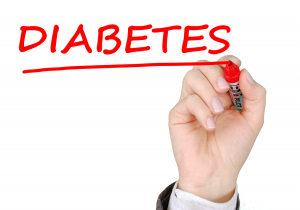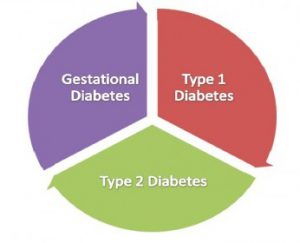What is diabetes?
 Diabetes is a disease that involves problems with your hormone insulin. Normally, the pancreas releases insulin to help your body store and use the sugar and fat from the fat you eat.
Diabetes is a disease that involves problems with your hormone insulin. Normally, the pancreas releases insulin to help your body store and use the sugar and fat from the fat you eat.
Diabetes can occur when the pancreas produces very little or no insulin, or when the body does not respond appropriately to insulin. As yet, there is no cure. People with diabetes need to manage their disease to stay healthy.
The role of insulin in diabetes
To understand why insulin is necessary for diabetes, it helps to know more about how the body uses food for energy. Your body is made up of millions of cells. These cells need food in a very simple form to make energy. When you eat or drink, much of your food is broken down into a simple sugar called glucose. This glucose is transported through the bloodstream to the cells of your body where it can be used to provide some of the energy your body needs for daily activities.
The hormone insulin tightly regulates the amount of glucose in your bloodstream. When you eat or drink, a small amount of insulin releases by the pancreas. When the amount of glucose in your blood rises to a certain level, the pancreas releases more insulin to push more glucose into the cells which cause the glucose levels in your blood to drop.
To keep your blood sugar levels from getting too low, your body signals you to eat and release some glucose from storage maintained in the liver.
People with diabetes either don’t make insulin, or their body cells are resistant to insulin, leading to high levels of sugar circulating in the blood, called high blood sugar. By definition, diabetes is having a blood glucose level of 126 milligrams per deciliter (mg/dL) or more after an overnight fast.
Types of Diabetes
Type-1 Diabetes
 Type-1 diabetes occurs because the insulin-producing cells of the pancreas, called beta cells, are destroyed by the immune system. People with type-1 diabetes produce no insulin and must use insulin injections to control their blood sugar.
Type-1 diabetes occurs because the insulin-producing cells of the pancreas, called beta cells, are destroyed by the immune system. People with type-1 diabetes produce no insulin and must use insulin injections to control their blood sugar.
Type-1 diabetes most commonly starts in people under the age of 20 but may occur at any age.
Type-2 Diabetes
Unlike people with type-1 diabetes, people with type-2 diabetes produce insulin. However, it is either not enough or the body is resistant to insulin. When there isn’t enough insulin, or it is not used as it should be, glucose can’t get into the body’s cells.
Type-2 diabetes is the most common form of diabetes, affecting almost 425 million people. While most of these cases can be prevented, it remains for adults who don’t take serious actions against their diabetes, the leading cause of diabetes-related complications such as blindness, non-traumatic amputations, and chronic kidney failure requiring dialysis. Type-2 diabetes usually occurs in people who are over age 40 and are overweight but can also happen in individuals who are not overweight.
Some people can manage their type-2 diabetes by controlling their weight, watching their diet and exercising regularly. Others may also need to take a pill that helps their body use insulin better, or take insulin injections.
Often, doctors can detect the likelihood of type-2 diabetes before the condition occurs. Commonly referred to as prediabetes, this condition occurs when a person’s blood sugar levels are higher than normal, but not enough for a diagnosis of type-2 diabetes.
Gestational Diabetes
Pregnancy triggers gestational diabetes. Hormone changes during pregnancy can affect insulin’s ability to work properly. The condition occurs in approximately 4% of all pregnancies.
Pregnant women who have an increased risk of developing gestational diabetes are those who are over 25 years old, are above their average body weight before pregnancy, or have a family history of diabetes.
Screening for gestational diabetes is performed during pregnancy. If left untreated, gestational diabetes increases the risk of complications to both the mother and her unborn child.
Usually, blood sugar levels return to normal within six weeks of childbirth. However, women who have had gestational diabetes have an increased risk of developing type-2 diabetes later in life.
What are the common symptoms of diabetes?
The symptoms of type-1 diabetes often occur suddenly and can be severe. They include:
- Increased thirst
- Frequent urination
- Dry mouth
- Increased hunger even after eating
- Heavy breathing
- Blurred vision
- Loss of consciousness
The symptoms of type-2 diabetes may be the same as those listed above. Most often, there are no symptoms or very gradual development of the above symptoms. Other symptoms may include:
- Slow-healing sores or cuts
- Numbness or tingling of hands and feet
- Yeast infections
- Itching of skin
- Recent weight gain
How is diabetes managed?
At present, diabetes can’t be cured, but it can be managed and controlled. The goals of managing diabetes are:
- To keep your blood sugar levels as near to normal as possible by balancing food intake with medication and physical activities.
- To maintain your blood cholesterol and lipid levels as near to their normal ranges as possible by avoiding added sugars and processed starches and by reducing saturated fats and cholesterol.
- To control your blood pressure. Your blood pressure should not be exceeded by 130/80.
- To slow or possibly prevent the development of diabetes-related health problems.
You hold the key to managing your diabetes by:
- Planning what you eat and following a balanced meal plan
- Exercising regularly
- Monitoring your blood sugar and blood pressure levels at home
- Taking medicine, if prescribed, and strictly following the guidelines on how and when to take it
- Keeping your appointments with health care providers and having laboratory tests as ordered by your doctor
Remember! What you do at home every day affects your blood sugar more than what your doctor can do every few months during your checkups.
